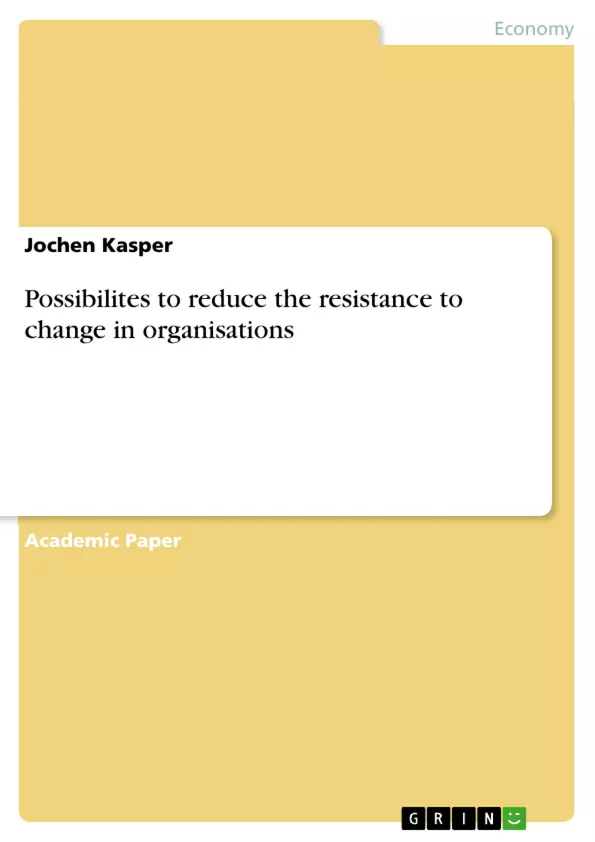This paper is about the resistance to change in organisations and what leaders can do to reduce resistance to change. Change management is a process of renewing organisations in terms of their structure, direction or capability. Organisational change is almost impossible to avoid. In today’s economic climate, which is characterised by profit orientation, competition, and technological progress, change is necessary to gain market shares or maintain a leading market position. Beer and Nohria (2000) put this in radical terms by claiming that most traditional companies have accepted that they have to change or die. Implementing change within large organisations can be challenging, however. The analysis of Kotter (2012) is as follows: “In many situations the improvements have been disappointing and the carnage has been appalling, with wasted resources and burned-out, scared or frustrated employees.” Whilst this may sound extreme, Kotter has a point given the fact that 70% of all changes fail. However, this paper will describe methods of reducing resistance to change and use the example of a case study to illustrate the answer.
Inhaltsverzeichnis (Table of Contents)
- Introduction
- Main Text
- Sources of resistance
- Case study
- Resistance within organisations
- Techniques to reduce resistance
- Communication
- Communication methods in the case study
- Approaches to motivation
- Maslow's hierarchy of needs
- Adam's equity theory
- Adam's equity theory in the case study
- Combination of communication and equity theory in the case study
- Manipulation and coercion
- Hultman's technique to reduce and overcome resistance
- Game theory
- Gamification in the case study
- Communication
- Conclusion
Zielsetzung und Themenschwerpunkte (Objectives and Key Themes)
This paper explores the issue of resistance to change within organizations and aims to outline strategies that leaders can employ to mitigate this resistance. The central focus is on change management as a process of organizational renewal involving modifications to structure, direction, or capabilities. The paper emphasizes the inevitability of change in today's competitive business environment, particularly in light of technological advancements and the pursuit of market dominance.
- The nature and sources of resistance to change within organizations
- Different models and theories explaining individuals' reactions to change
- Effective communication strategies and techniques to reduce resistance
- Motivation and its role in managing change through frameworks like Maslow's hierarchy of needs and Adam's equity theory
- The use of manipulation and coercion as change management tactics
Zusammenfassung der Kapitel (Chapter Summaries)
The introduction of this paper highlights the prevalence and challenges associated with resistance to change in organizations. It emphasizes the importance of addressing this resistance to achieve successful organizational transformation.
The chapter titled "Sources of resistance" examines the psychological processes individuals go through when confronted with change. It explores various models that describe the stages of transition and reactions to change, emphasizing the human tendency towards resistance as a defense mechanism against uncertainty and disruption. Different perspectives on resistance are presented, highlighting its multifaceted nature and significance as a driving force maintaining the status quo.
This chapter further discusses a case study, which provides a practical example to illustrate the dynamics of resistance to change within an organizational context. The case study serves as a basis for exploring various strategies and techniques that can be implemented to reduce resistance.
The chapter titled "Techniques to reduce resistance" dives into various approaches aimed at mitigating resistance to change. It explores the importance of communication as a key tool for managing change, highlighting different communication methods and their application in the case study. This chapter also delves into the role of motivation in facilitating change, specifically examining Maslow's hierarchy of needs and Adam's equity theory as frameworks for understanding and addressing employee motivation. The application of these theories in the case study is examined, demonstrating their practical implications.
The chapter further explores the use of manipulation and coercion as change management tactics. It discusses Hultman's technique for reducing and overcoming resistance, examining its effectiveness and potential drawbacks. The chapter also touches on game theory as a framework for managing change, specifically focusing on gamification techniques and their application in the case study.
Schlüsselwörter (Keywords)
Change management, resistance to change, organizational change, communication strategies, motivation theories, Maslow's hierarchy of needs, Adam's equity theory, manipulation, coercion, game theory, gamification, case study.
- Quote paper
- Jochen Kasper (Author), 2014, Possibilites to reduce the resistance to change in organisations, Munich, GRIN Verlag, https://www.grin.com/document/279256



